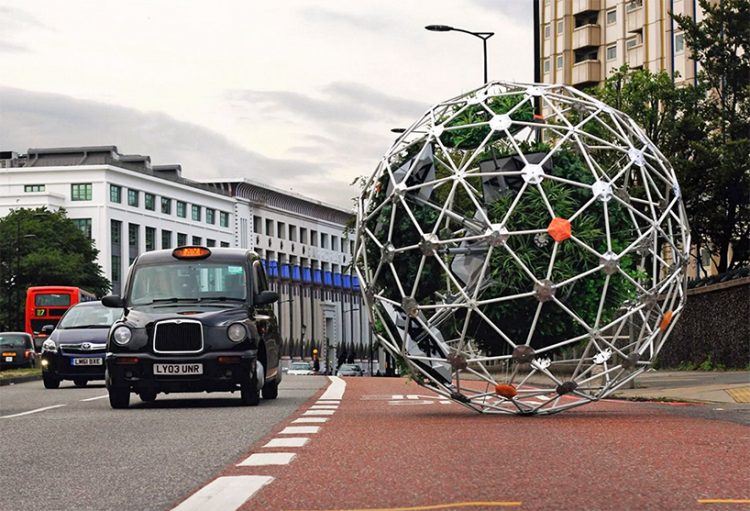
Its technical name is hortum machina B, and it is the intelligent robot garden child of Danilo Sampaio and William Victor Camilleri. These enterprising Masters program students at the Bartlett School of Architecture, UCL in London, participate in a research team that is multi-disciplinary. Their half machine, half garden structure is described as an “urban cyber gardener,” and they view their new child in three ways. They describe it as an art project, a technical investigation, and an architectural proposal.
The research team works at the university’s Interactive Architecture Lab. Hortum machina B is one part of the program called the reEarth project. Participants seek to find ways to integrate plants and buildings in such a way that the plants are viewed as living systems, with the ultimate goal being plants that are self-reliant, able to function autonomously, and interact with society…even to the point of walking along with humans. The project acknowledges that buildings are static and not aligned with nature. It seeks to find ways to create more gardens to replenish the Earth in an age when gardens are generally in decline.
To look at hortum machina B, is to see a round, open geodesic sphere filled with plants. The sphere’s exoskeleton is white, and the green plants thriving inside are a beautiful contrast to the bright white color. It takes its architecture from Buckminster Fuller’s geodesic domes. The plants at the core of the sphere are native British, and they are planted in twelve modules. Each of these twelve gardens is capable of adjusting from the center outward or inward, and when the modules adjust to take advantage of the environment, the sphere rolls to a new position because the center of gravity changes.
Plants are capable of sensing their environment. They are stimulated electro-chemically in their environment even though they have no nervous system. The team used an autonomous robotic wiring system coupled with electro-physiology to connect the plants to their exoskeleton; essentially giving the plants the control over whether or not their garden modules will adjust to the environment.

The technical details of what takes place inside the sphere sound futuristic to the non-scientist. Some call it an “ecological rolling life form”. Inside its exoskeleton, sensors use electro-physiology to monitor individual plants. It has a robot brain which receives the sensory information collected together from the individual plants to process choices about where it will move and when. The environment affects the plants inside, and they react chemically to it. All of the sensors inside the interior function together to dictate the sphere’s orientation to the sun, wind, rain and temperature. The sphere moves to the best location for the plants inside, though perhaps slowly.
All discussion and description aside, it was created to demonstrate that new built environments could be created which would enhance interaction between humans and the natural world. In the future, new ways of gardening could provide more green in city centers or even more edible produce. The future possibilities are only just beginning to emerge.
While Camilleri, Sampaio and their team view hortum machina B as a technological vessel for preserving the native plant species of Britain while bringing nature and mankind together, London residents are reacting to the robot gardener with curiosity and surprise. After all, hortum machina B rolls to optimal sunshine and has a mind of its own. Though some Brits are often reserved, when hortum machina B rotates or the interior gardens interchange unexpectedly, everyone nearby can be caught off guard. Smiles, side-steps, deft dancing around the geodesic structure and pointing unabashedly all have been captured on recent team research videos.
Hortum machina B has been sighted on walkways, in parks, alongside busy streets and sidewalks. Those strolling and cycling by have needed to give it extra room. Some may wonder if it could cause a traffic jam.
As an art form, it provides high visual contrast to the iconic black taxi cabs and red double-deck buses which transport people daily in central London. As contemporary as the London Eye, which added a significant level of modernity to the traditional skyline, hortum machina B cannot avoid attracting attention in its own way. It will take time for this gardening experiment to come to any definitive conclusion. The urban cyber gardener may not bring a huge amount of green plants to the city, but it is guaranteed to evoke plenty of conversation.


Comments
Loading…